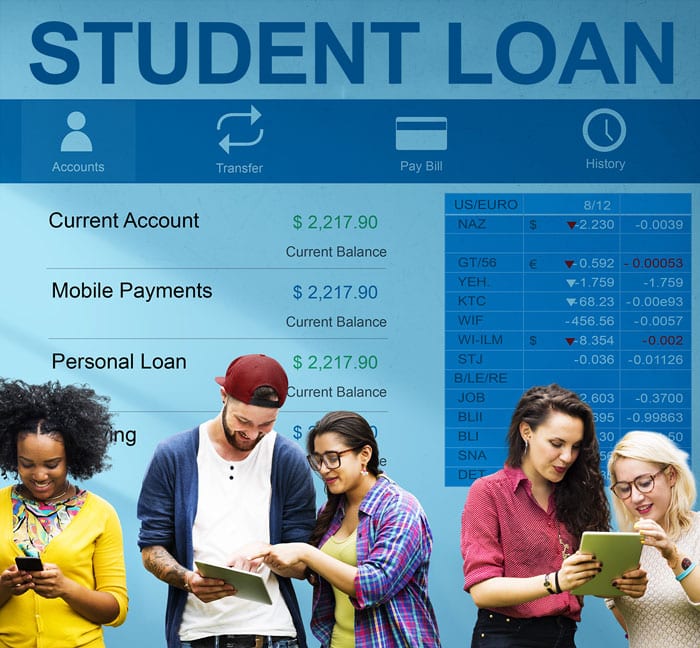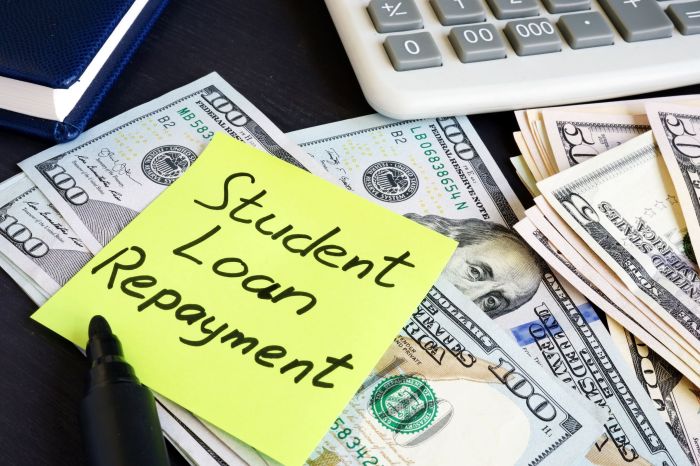
Navigating the complexities of student loan repayment can feel overwhelming, but understanding the available options and strategies is crucial for long-term financial well-being. This guide delves into the current landscape of student loan debt in the United States, exploring the various types of loans, repayment plans, and government programs designed to assist borrowers. We’ll examine the impact of student loan debt on major life decisions and offer practical advice for managing debt effectively while achieving other financial goals.
From creating a personalized repayment plan to understanding the nuances of income-driven repayment and loan forgiveness programs, we aim to provide a clear and concise roadmap for successfully managing your student loan debt. We’ll also address common misconceptions and pitfalls, empowering you to make informed decisions and build a secure financial future.
The Burden of Student Loan Debt

The weight of student loan debt in the United States is a significant and growing concern, impacting millions of individuals and the overall economy. The sheer volume of debt, coupled with its long-term consequences, creates a complex web of financial and psychological challenges for borrowers. Understanding the scope of this issue is crucial for developing effective solutions and providing support to those affected.
The Current State of Student Loan Debt in the United States
Student loan debt in the United States has reached staggering levels. As of 2023, the total amount of student loan debt surpasses $1.7 trillion, exceeding both credit card and auto loan debt. The average student loan debt for borrowers is around $37,000, although this figure varies significantly depending on the degree pursued, the institution attended, and the borrower’s personal circumstances. The national student loan default rate, while fluctuating, remains a substantial concern, indicating a significant portion of borrowers struggle to manage their repayments. These high debt levels and default rates contribute to a range of economic and social problems, impacting individuals’ ability to save for retirement, purchase homes, and start families.
Psychological Impact of Significant Student Loan Debt
The psychological toll of substantial student loan debt is often underestimated. The constant pressure of repayment can lead to significant stress, anxiety, and even depression. Borrowers may experience feelings of overwhelm, hopelessness, and a diminished sense of financial security. This can negatively impact mental health, relationships, and overall well-being. The long-term burden of repayment can also affect major life decisions, such as career choices, marriage, and homeownership. For example, some graduates might postpone starting a family or buying a house due to the financial constraints imposed by student loans, leading to significant life changes and potential regrets.
Types of Student Loans and Interest Rates
Several types of student loans exist, each with its own interest rate and repayment terms. Federal student loans, offered by the government, generally have lower interest rates and more flexible repayment options compared to private student loans. Federal loans include subsidized loans (interest does not accrue while the student is enrolled at least half-time) and unsubsidized loans (interest accrues regardless of enrollment status). Private student loans, offered by banks and other financial institutions, often come with higher interest rates and stricter repayment terms. The interest rate on both federal and private student loans can vary depending on factors such as creditworthiness, the type of loan, and prevailing market interest rates. Understanding these differences is crucial for borrowers to make informed decisions.
Comparison of Student Loan Repayment Plans
Choosing the right repayment plan is vital for managing student loan debt effectively. Different plans offer varying monthly payments and repayment periods.
| Plan Name | Monthly Payment Calculation Method | Repayment Period | Potential for Loan Forgiveness |
|---|---|---|---|
| Standard Repayment Plan | Fixed monthly payment over 10 years | 10 years | No |
| Income-Driven Repayment (IDR) Plan (e.g., ICR, PAYE, REPAYE) | Based on income and family size; payment adjusted annually | 20-25 years | Potential for forgiveness after 20-25 years, depending on the plan and income |
| Extended Repayment Plan | Fixed monthly payment over a longer period (up to 25 years) | Up to 25 years | No |
| Graduated Repayment Plan | Payments start low and gradually increase over time | 10 years | No |
Repayment Strategies and Options
Navigating student loan repayment can feel overwhelming, but a strategic approach can significantly reduce stress and accelerate your journey to debt freedom. Understanding your options and creating a personalized plan are crucial first steps. This section Artikels various repayment strategies and helps you determine the best path for your individual circumstances.
Creating a Personalized Student Loan Repayment Plan
Developing a personalized plan involves several key steps. First, gather all your loan information, including lender details, interest rates, and minimum monthly payments. Next, assess your current financial situation, including income, expenses, and savings. This allows you to determine a realistic monthly payment amount. Then, prioritize your loans based on interest rates – focusing on higher-interest loans first is generally the most efficient strategy. Finally, create a budget that incorporates your student loan payments and stick to it. Regularly review and adjust your plan as your financial situation changes.
Income-Driven Repayment (IDR) Plans: A Comparison
Income-driven repayment plans adjust your monthly payment based on your income and family size. Several plans exist, each with its own eligibility criteria and payment calculations. For example, the Revised Pay As You Earn (REPAYE) plan typically caps monthly payments at 10% of discretionary income, while the Income-Based Repayment (IBR) plan has similar features but with slightly different calculations. The primary benefit of IDR plans is lower monthly payments, making them manageable for borrowers with limited income. However, drawbacks include potentially longer repayment periods, leading to higher overall interest paid, and the possibility of loan forgiveness after 20-25 years (depending on the plan), which may be taxable income. Careful consideration of long-term implications is essential before opting for an IDR plan.
Strategies for Accelerating Loan Repayment
Accelerating repayment involves actively reducing your loan balance faster than the standard repayment schedule. Making extra payments, even small amounts, significantly reduces the principal balance and the total interest paid over the life of the loan. Consider automating extra payments to ensure consistency. Refinancing your loans with a lower interest rate can also drastically reduce your monthly payments and shorten your repayment timeline. However, refinancing may not always be beneficial, particularly if you have federal loans with government benefits such as income-driven repayment plans. Careful evaluation of interest rates and fees is crucial before refinancing.
Choosing a Repayment Plan: A Decision-Making Flowchart
The following flowchart illustrates the decision-making process for selecting the most appropriate student loan repayment plan:
[Descriptive text of a flowchart. The flowchart would begin with a “Start” box. The first decision point would be: “Do you have a stable income and the ability to make higher monthly payments?” A “Yes” branch would lead to a box suggesting exploring standard repayment plans and strategies for accelerating repayment. A “No” branch would lead to a decision point: “Are you eligible for an Income-Driven Repayment plan?” A “Yes” branch would lead to a box detailing the various IDR plans and their respective criteria. A “No” branch would lead to a box suggesting exploring options like deferment or forbearance (with caveats about the accruing interest). All branches would ultimately converge to an “End” box.]
The Impact of Student Loan Debt on Financial Decisions

Student loan debt significantly impacts major life decisions, influencing everything from homeownership and marriage to family planning. The weight of monthly payments and the overall debt burden can create considerable financial constraints, forcing individuals to carefully consider their options and prioritize spending. Understanding this impact is crucial for effective financial planning and achieving long-term goals.
Student Loan Debt’s Influence on Major Life Decisions
The presence of substantial student loan debt often delays or alters major life decisions. Buying a home, for instance, becomes more challenging due to the impact of debt-to-income ratios used by lenders. Similarly, the financial commitment of marriage and starting a family – including childcare costs and potential loss of income – can be significantly amplified by existing student loan payments. Many individuals find themselves postponing these milestones until their debt is significantly reduced or eliminated. This delay can have emotional and social consequences as well as financial ones.
Successful Debt Management and Achievement of Financial Goals
Despite the challenges, many individuals successfully navigate student loan debt while achieving other financial goals. For example, a couple in Denver, Colorado, meticulously budgeted their income, prioritizing aggressive student loan repayment while simultaneously saving for a down payment on a modest home. Through consistent contributions to a high-yield savings account and careful expense tracking, they managed to buy a home within three years of graduating, significantly reducing their stress and improving their quality of life. Another example is a young professional in New York City who prioritized high-earning potential in their career choice, allowing them to aggressively pay down their student loans while still saving for retirement and travel. Their strategic career path and disciplined financial planning enabled them to balance their debt burden with personal aspirations.
Common Financial Mistakes Made While Managing Student Loan Debt
Ignoring the debt or minimizing its impact is a prevalent mistake. Failing to create a realistic budget that accounts for loan payments and other expenses can lead to financial instability. Another common error is neglecting to explore various repayment options, such as income-driven repayment plans or loan refinancing. Furthermore, accumulating additional debt through credit cards or high-interest loans while struggling with student loans can exacerbate the financial burden and create a vicious cycle of debt. Finally, not prioritizing financial literacy and seeking professional advice can hinder effective debt management.
Tips for Budgeting and Saving While Paying Off Student Loans
Creating a detailed budget is paramount. Track all income and expenses meticulously to identify areas where spending can be reduced. Prioritize high-interest debts first to minimize overall interest payments. Automate loan payments and savings contributions to ensure consistency. Explore options for increasing income, such as taking on a side hustle or negotiating a raise. Consider utilizing budgeting apps and financial planning tools to streamline the process. Seek professional financial advice to create a personalized debt repayment plan.
Government Programs and Loan Forgiveness

Navigating the complex landscape of student loan repayment can be daunting. Fortunately, several government programs exist to help borrowers manage their debt and, in some cases, achieve loan forgiveness. Understanding these programs, their eligibility requirements, and potential long-term implications is crucial for effective financial planning.
Income-Driven Repayment Plans
Income-driven repayment (IDR) plans adjust your monthly student loan payments based on your income and family size. This ensures that your payments are manageable, preventing delinquency and default. Several IDR plans are available, including Revised Pay As You Earn (REPAYE), Income-Based Repayment (IBR), Income-Contingent Repayment (ICR), and Pay As You Earn (PAYE). Each plan has slightly different eligibility requirements and calculation methods for determining your monthly payment. For example, REPAYE considers both undergraduate and graduate loans, while IBR may have different eligibility criteria based on loan origination date. Choosing the right plan depends on individual circumstances and should be carefully considered.
Public Service Loan Forgiveness (PSLF) Program
The Public Service Loan Forgiveness (PSLF) program offers complete loan forgiveness after 120 qualifying monthly payments under an IDR plan while working full-time for a qualifying government or non-profit organization. Eligibility requires direct loans, consistent employment, and adherence to the IDR plan terms throughout the 10-year period. The program has faced criticism for its complex requirements and relatively low success rate, with many borrowers failing to meet all eligibility criteria. However, recent changes have aimed to simplify the process and increase forgiveness rates. For example, temporary waivers have been implemented to address past administrative errors.
Teacher Loan Forgiveness Program
This program provides forgiveness for up to $17,500 of federal student loan debt for teachers who have completed five years of full-time teaching in a low-income school or educational service agency. Teachers must meet specific requirements, including teaching in a qualifying school and having qualifying federal student loans. The program is designed to incentivize individuals to pursue careers in education, particularly in underserved communities.
Application Process for Income-Driven Repayment and Loan Forgiveness Programs
The application process typically involves completing a form on the StudentAid.gov website. This includes providing details about your income, family size, and student loans. For IDR plans, you will need to select the plan that best suits your needs and provide the necessary documentation to verify your income and family size. For loan forgiveness programs, you will need to demonstrate that you meet all the eligibility requirements and provide proof of employment and qualifying service. The process can be lengthy, and careful documentation is crucial. It’s advisable to keep detailed records of your income, employment history, and loan payments. For instance, maintaining copies of your tax returns and employment verification letters is essential. Regularly checking your loan servicer’s website for updates and progress is also recommended.
Potential Long-Term Economic Consequences of Loan Forgiveness Programs
Large-scale student loan forgiveness programs could have significant economic effects. Arguments for forgiveness often center on stimulating consumer spending and boosting economic growth. Conversely, concerns exist about the potential inflationary pressures and the impact on future borrowing costs. Some argue that forgiveness could disproportionately benefit high earners, while others emphasize the positive social benefits of reducing economic inequality and improving access to higher education. The long-term impact will likely depend on the scale and design of any forgiveness program, along with broader economic conditions. For example, a targeted program focused on specific demographics or loan types might have a different impact than a broad-based forgiveness initiative.
The Future of Student Loan Debt
The escalating burden of student loan debt presents a significant challenge to individual borrowers and the overall economy. Understanding potential future trends and exploring viable solutions is crucial to mitigating its impact on future generations and ensuring a more equitable and accessible higher education system. Failure to address this issue could lead to long-term economic stagnation and increased social inequality.
Predicting the future of student loan debt requires considering several interconnected factors, including tuition inflation, economic growth, and government policies. While precise forecasting is impossible, several plausible scenarios emerge based on current trends.
Projected Growth of Student Loan Debt
A visual representation of projected student loan debt growth over the next decade could be depicted as a sharply ascending line graph. The y-axis would represent the total amount of student loan debt in trillions of dollars, while the x-axis represents the years from the present to ten years into the future. The line would start at the current level of student loan debt and rise steadily, possibly exhibiting an accelerated increase in later years, reflecting the compounding effect of interest and the continued rise in tuition costs. For example, if current trends continue, the graph might show a jump from approximately $1.7 trillion today to a projected $3 trillion or more within a decade. This projection assumes no significant policy interventions to curb the growth. Real-world examples like the consistent increase in tuition fees at many universities, coupled with the slow growth of median incomes, would underpin this upward trajectory.
Potential Solutions to Address the Growing Problem of Student Loan Debt
Several strategies could help address the growing problem. These include increased government funding for need-based grants and scholarships to reduce reliance on loans, implementation of income-driven repayment plans that better align monthly payments with borrowers’ earning capacity, and stricter regulation of for-profit colleges to curb predatory lending practices. Furthermore, initiatives promoting financial literacy among prospective students and their families can empower informed decision-making about higher education financing. The success of these strategies depends on political will and effective implementation. For instance, the success of income-driven repayment plans depends on their accessibility and affordability, and government funding for grants requires substantial budgetary allocations.
The Role of Higher Education Institutions in Mitigating Student Loan Debt
Colleges and universities have a crucial role to play in reducing student loan debt. Institutions can prioritize affordability by controlling tuition increases, investing in more affordable online and hybrid learning options, and increasing the availability of merit-based and need-based financial aid. They can also enhance career services to improve graduates’ employment prospects and earning potential, thereby improving their ability to repay loans. For example, universities can partner with businesses to create internship opportunities and job placement programs, and offer more career counseling services to students. Transparency in disclosing the cost of education and potential return on investment is also crucial.
Summary
Successfully managing student loan debt requires proactive planning, informed decision-making, and a commitment to financial responsibility. By understanding the various repayment options, leveraging available resources, and avoiding common pitfalls, borrowers can navigate this challenging process and achieve long-term financial stability. This guide has provided a framework for understanding the complexities of student loan repayment, empowering you to take control of your financial future and build a brighter tomorrow.
Expert Answers
What happens if I miss a student loan payment?
Missing payments can lead to late fees, damage your credit score, and potentially result in loan default, impacting your ability to obtain future credit.
Can I consolidate my student loans?
Yes, loan consolidation combines multiple loans into a single loan, potentially simplifying repayment. However, it may not always lower your interest rate.
What is the difference between subsidized and unsubsidized loans?
Subsidized loans don’t accrue interest while you’re in school, whereas unsubsidized loans do.
Are there any tax benefits for paying student loans?
Some tax deductions and credits may be available depending on your income and repayment plan. Consult a tax professional for personalized advice.
